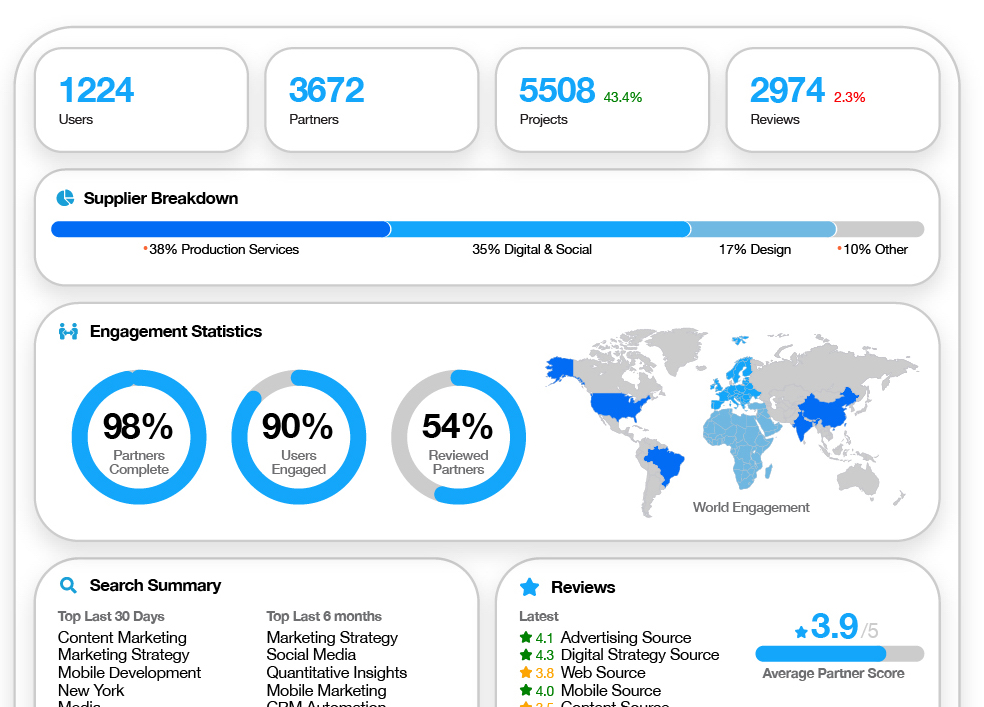Spend management for professional services hasn’t been optimized, even at Fortune 500 companies who spend millions on supply chain management. Since professional services like marketing agencies fall into what finance calls indirect spend, they haven’t been a big focus until recently. Research across the Fortune 1000 shows that now, indirect spend has ballooned to 20 – 40% of their total spend.¹ That has CFOs and other leaders paying attention.
Getting a handle on cost is hard enough, but in the services space, we have discovered many more complexities that are extremely important to consider versus traditional procurement approaches.
Tackling Distributed Decision Making
The first thing you have to realize is that services, and most of indirect spend, are now being purchased at all levels and across all parts of the business. Unlike traditional procurement, these aren’t funneling to a buyer. There are simply too many purchases of all sorts and not enough people. Even where there are dedicated procurement teams, like those in marketing procurement, you can’t solve the bigger issue here with bodies. The quantity of deals is too vast.

Today, every Fortune 500 company we speak to seems to be trying to use spreadsheets to manage hundreds or thousands of suppliers. Even when I was a Global Group Director at Coca-Cola, I would be given a spreadsheet with a list of marketing agency names on it.
Tip 1: You can’t solve this with spreadsheets. You need a software solution.
No one, especially no one in marketing, trusts a name on a spreadsheet that someone else put there without any contextual data to support a closer look. Stop wasting everyone’s time with spreadsheets.
Stuck On the “Add Another Supplier” Treadmill

I know that most of the Fortune 500 use platforms like SAP Ariba, but the people buying these services either don’t have access to Ariba or don’t want to have access to Ariba. Plus, systems like Ariba do not have the right data and interface to solve the indirect spend problem, especially not for professional services. That is exactly why, procurement started circulating spreadsheets to begin with.
All these spreadsheets do is exacerbate the real problem, lack of contextual data and specialized software to help everyone access that data to make better decisions.
Our research shows that every company with one hundred or more service suppliers in an area like marketing, IT, R&D, or even external manufacturing, is wasting huge amounts of time.
Here’s what happens: Professionals look at the spreadsheet and are overwhelmed by the sea of company names. They recognize one name and either pull up the website or email the one contact person listed. Then, if the website is working they realize this company isn’t an expert in the service they need, or, if they email the contact, there is about a 80% chance that the email bounces or that it’s someone in the finance department.
“Marketing kept adding more agencies. We never realized it was because they had no way to search suppliers and quickly identify the most relevant ones.”
–VP Marketing Procurement at Global Company
At that point, most start looking for their own agency and throw the spreadsheet in the trash. This wastes a lot of people’s time and once they do find the partner they want to work with, they waste time with legal, procurement, and others just getting a brand new supplier onboarded to start the engagement. On the low end, searching for, vetting, and adding a supplier costs the company 200 hours of time. Let’s be honest, most deals at Fortune 500 companies take a lot more time than that.
Just think of all of those hours and how the company could have spent them if it was easy to identify the right partner from within the approved supplier roster, with the right capabilities, and know that other colleagues had rated that partner’s performance very high.
Tip 2: It is time for companies to live up to their promise to approved suppliers. The broken promise of procurement that “if you deliver great work at a good cost, we will continue to spend with you and likely spend more.“
Instead of continually adding one more supplier, it’s time to stop the “add a partner” treadmill. Today, brands end up spreading their spend very thin among a large number of suppliers. This part of the procurement process is extremely broken. Let’s fix it today.
Smarter Spend Begins With Empowered People Who Have Confidence in the Data
Most specialists within large corporations have been living and operating in a data vacuum when it comes to their services supply chain partners. It doesn’t matter if they are in marketing, IT, R&D or another specialist function, they are extremely frustrated by the spreadsheet they get with the data they do not trust. Yet, leadership is often telling them to use approved suppliers.
Smarter spend begins with changing this scenario. People are the most valuable part of most companies. Let’s empower them with the right tool so that they can do their jobs better. Let’s make work easier. This will save a ton of time, result in happier employees, healthier partner relationships, and produce better results faster.
This is exactly why notable brands like HP, Nike, and Unilever are turning to SpotSource. In three months, we can transform that spreadsheet into a rich pool of data that empowers people to find the best fit approved partner, at the best price, and with the right quality. We answer questions like: Who in our company has worked with them? What are they great at? How well are they performing?
Tip 3: With SpotSource, empowered employees are naturally consolidating spend to the best fit partners within the approved supplier and they are asking to add new suppliers dramatically less often.
To transform your supply chain, you need tools that help employees quickly identify the best provider. By simply unifying data, SpotSource helps professionals make better decisions and drive better performance. In fact, it has been reported that 81% of supply chain managers believe data analytics will be crucial when it comes to reducing costs.²
The journey to empower your employees begins by providing them with the proper tools and data organized in an easy to use interface. In addition to this, it’s crucial that all decision makers have access to the tool. This is one of the main issues with other enterprise systems, the data is fragmented, and not everyone has access or the right level of permissions.
Technology Is Transforming Supply Chain
It’s hard to believe in today’s age that a Fortune 500 company would rely on a spreadsheet to keep track of such important data, but this is the case for many functions who use service suppliers that were once considered indirect spend. Other than being outdated, these spreadsheets simply do not contain the right data to drive solid decision making for the individual purchase and certainly lack the right data for leadership to orchestrate their supplier relationships and identify the areas that need their time and focus.

Beyond that, empowering people and capturing performance data will help procurement and others identify new areas of opportunity. For example, professionals within our customers are flagging partners who they feel aren’t delivering the right value for money spent. How valuable is it to know, at a glance, that 50 out of 600 suppliers are in the red based on asking experts about their value for money?
Take the guesswork and friction out of the equation and transform how your company manages its service supply chain for marketing, IT, R&D, external manufacturing and more.
It’s nearly impossible for employees to succeed if they aren’t given adequate tools and the data to make the best decisions. According to a recent study, 50% of companies believe that technological advancements have a strong impact on the supply chain, logistics, and transportation operations.³ And, it’s for this reason that an increasing number of companies are so interested in trading out their spreadsheets for SpotSource.
References
¹ Accenture | ² The Hackett Group | ³ Forbes